Table of Contents
Fibre to Fabric
Paheli and Boojho won the first prize in a Science Quiz competition held at their school. They were very excited and decided to use the prize money to buy clothes for their parents. When they saw a large variety of cloth material, they got confused (Fig. 3.1). The shopkeeper explained that some clothes or fabrics were cotton and some were synthetic. He also had woollen mufflers and shawls. There were many silk sarees as well. Paheli and Boojho felt very excited. They touched and felt these different fabrics. Finally, they bought a woollen muffler and a cotton saree.
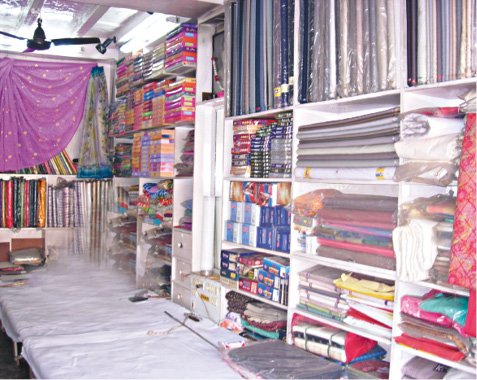
After their visit to the cloth shop, Paheli and Boojho began to notice various fabrics in their surroundings. They found that bed sheets, blankets, curtains, tablecloths, towels and dusters were made from different kinds of fabrics. Even their school bags and the gunny bags were made from some kind of fabric. They tried to identify these fabrics as cotton, wool, silk or synthetic. Can you also identify some fabrics?
3.1 Variety in Fabrics
Activity 1
Visit a nearby tailoring shop.
Collect cuttings of fabrics leftover after stitching. Feel and touch each piece of fabric. Now, try to label some of the fabrics as cotton, silk, wool or synthetic after asking for help from the tailor.
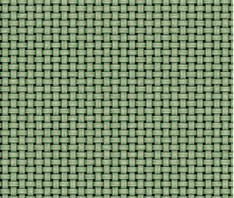
Fig.3.2 Enlarged view of a piece of fabric
Do you wonder what these different fabrics are made of? When you look at any fabric, it seems a continuous piece. Now, look at it closely. What do you notice (Fig. 3.2)?
Activity 2
Select a piece of cotton fabric you labelled in Activity 1. Now, try to find a loose thread or yarn at one of the edges and pull it out (Fig. 3.3). If no loose yarns are visible, you can gently pull one out with a pin or a needle.
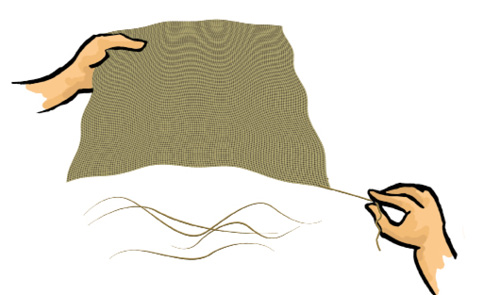
Fig. 3.3 Pulling a thread from a fabric
We find that a fabric is made up of yarns arranged together. What are these yarns made of?
3.2 Fibre
Activity 3
Take out a yarn from a piece of cotton fabric. Place this piece of yarn on the table. Now, press one end of the yarn with your thumb. Scratch the other end of the yarn along its length with your nail as shown in Fig. 3.4. Do you find that at this end, the yarn splits up into thin strands (Fig. 3.5)?

Fig.3.4 Splitting the yarn into thin strands

Fig. 3.5 Yarn split up into thin strands
You might have observed something similar when you try to thread a needle. Many a time, the end of the thread is separated into a few thin strands. This makes it difficult to pass the thread through the eye of the needle. The thin strands of thread that we see, are made up of still thinner strands called fibres.
Fabrics are made up of yarns and yarns are further made up of fibres. Where do these fibres come from?
The fibres of some fabrics such as cotton, jute, silk and wool are obtained from plants and animals. These are called natural fibres. Cotton and jute are examples of fibres obtained from plants. Wool and silk fibres are obtained from animals. Wool is obtained from the fleece of sheep or goat. It is also obtained from the hair of rabbits, yak and camels. Silk fibre is drawn from the cocoon of silkworm.

For thousands of years natural fibres were the only ones available for making fabrics. In the last hundred years or so, fibres are also made from chemical substances, which are not obtained from plant or animal sources. These are called synthetic fibres. Some examples of synthetic fibres are polyester, nylon and acrylic.
3.3 Some Plant Fibres
Cotton
Have you ever made wicks for oil lamps? What do you use for making these wicks? This cotton wool is also used for filling mattresses, quilts or pillows.
Take some cotton wool, pull it apart and look at its edges. What do you observe? The small, thin strands that you see are made up of cotton fibres.
Where does this cotton wool come from? It is grown in the fields. Cotton plants are usually grown at places having black soil and warm climate. Can you name some states of our country where cotton is grown? The fruits of the cotton plant (cotton bolls) are about the size of a lemon. After maturing, the bolls burst open and the seeds covered with cotton fibres can be seen. Have you ever seen a cotton field that is ready for picking? It looks like a field covered with snow (Fig.3.6).
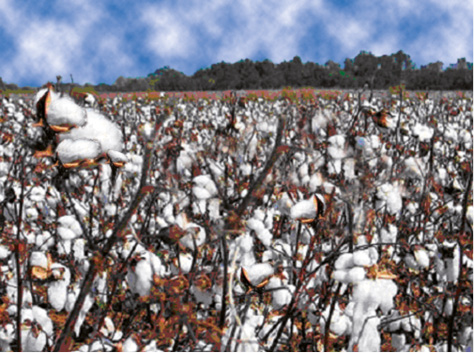
Fig.3.6 Field of cotton plants
From these bolls, cotton is usually picked by hand. Fibres are then separated from the seeds by combing. This process is called ginning of cotton. Ginning was traditionally done by hand (Fig.3.7). These days, machines are also used for ginning.
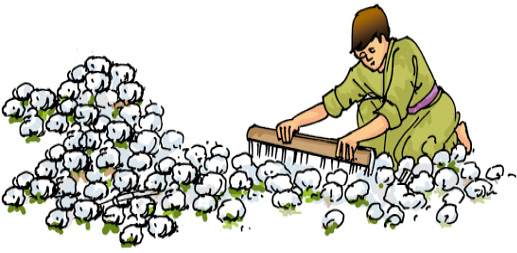
Fig. 3.7 Ginning of cotton
Jute
Jute fibre is obtained from the stem of the jute plant (Fig 3.8). It is cultivated during the rainy season. In India, jute is mainly grown in West Bengal, Bihar and Assam. The jute plant is normally harvested when it is at flowering stage. The stems of the harvested plants are immersed in water for a few days. The stems rot and fibres are separated by hand.

Fig. 3.8 A jute plant
To make fabrics, all these fibres are first converted into yarns. How is it done?
3.4 Spinning Cotton Yarn
You can try making cotton yarn yourself.
Activity 4
Hold some cotton wool in one hand. Pinch some cotton between the thumb and forefinger of the other hand. Now, gently start pulling out the cotton, while continuously twisting the fibres (Fig. 3.9). Are you able to make a yarn?
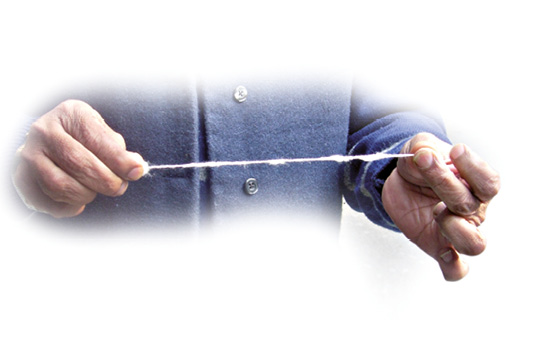
Fig. 3.9 Making yarn from cotton
The process of making yarn from fibres is called spinning. In this process, fibres from a mass of cotton wool are drawn out and twisted. This brings the fibres together to form a yarn.
A simple device used for spinning is a hand spindle, also called takli (Fig. 3.10). Another hand operated device used for spinning is charkha (Fig. 3.11). Use of charkha was popularised by Mahatma Gandhi as part of the Independence movement. He encouraged people to wear clothes made of homespun yarn termed as khadi and shun imported cloth made in the mills of Britain. To popularise and promote khadi, the Government of India constituted a body called Khadi and Village Industries Commission in 1956.


Fig. 3.11 Charkha
Spinning of yarn on a large scale is done with the help of spinning machines. After spinning, yarns are used for making fabrics.
3.5 Yarn to Fabric
There are many ways by which fabrics are made from yarns. The two main processes are weaving and knitting.
Weaving
In Activity 2, you might have noticed that a fabric is made up of two sets of yarns arranged together. The process of arranging two sets of yarns together to make a fabric is called weaving. Let us try to weave some paper strips.
Activity 5
Take two sheets of paper of different colours. Cut square pieces of length and width equal to 30 cm from each sheet. Now, fold both the sheets into half. On one sheet draw lines as shown in the Fig 3.12 (a) and on the other as shown in Fig.3.12 (b). Cut both the sheets along the dotted lines and then unfold. Weave the strips one by one through the cuts in the sheet of paper as shown in Fig.3.12 (c). Fig. 3.12 (d) shows the pattern after weaving all the strips.

Fig. 3.12 Weaving with paper strips
In a similar manner, two sets of yarn are woven to make a fabric. The yarns are much thinner than our paper strips, of course! Weaving of fabric is done on looms (Fig. 3.13). The looms are either hand operated or power operated.
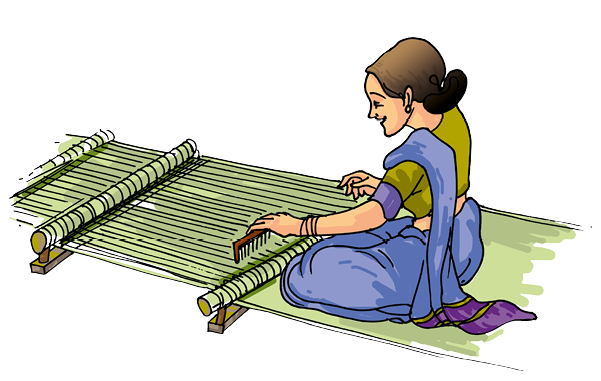
Knitting
Have you noticed how sweaters are knitted? In knitting, a single yarn is used to make a piece of fabric (Fig. 3.14). Have you ever pulled the yarn from a torn pair of socks? What happens? A single yarn gets pulled out continuously as the fabric gets unravelled. Socks and many other clothing items are made of knitted fabrics. Knitting is done by hand and also on machines.
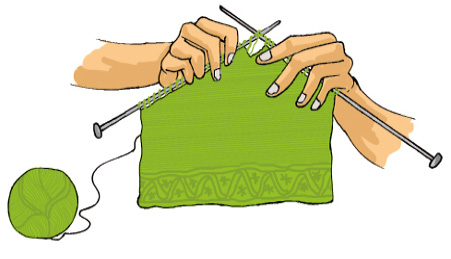
Fig 3.14 Knitting

Weaving and knitting are used for making different kinds of fabric. These fabrics are used for a variety of clothing items.
3.6 History of Clothing Material
Have you ever wondered what materials people used in ancient times for clothes? It appears that in those times people used the bark and big leaves of trees or animal skins and furs to cover themselves.
After people began to settle in agricultural communities, they learnt to weave twigs and grass into mats and baskets. Vines, animal fleece or hair were twisted together into long strands. These were woven into fabrics. The early Indians wore fabrics made out of cotton that grew in the regions near the river Ganga. Flax is also a plant that gives natural fibres. In ancient Egypt, cotton as well as flax were cultivated near the river Nile and were used for making fabrics.
In those days, stitching was not known. People simply draped the fabrics around different parts of their body. Many different ways of draping fabrics were used. With the invention of the sewing needle, people started stitching fabrics to make clothes. Stitched clothes have gone through many variations since this invention. But, is it not amazing that even today saree, dhoti, lungi or turban is used as an un-stitched piece of fabric?
Just as there is a large variety in the food eaten all over our country, a large variety exists also in fabrics and clothing items.

KeyWords
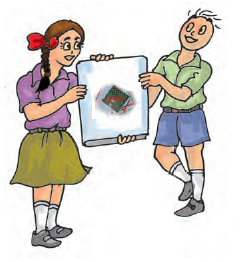
Summary
- There is a variety of clothing material or fabric, such as, cotton, silk, wool and polyester.
- Fabrics are made from yarns, which in turn are made from fibres.
- Fibres are either natural or synthetic. Cotton, wool, silk and jute are some natural fibres, while nylon and polyester are some examples of synthetic fibres.
- Fibres like cotton and jute are obtained from plants.
- The process of making yarn from fibres is called spinning.
- Fabric from yarns is made by weaving and knitting.
Exercise
1. Classify the following fibres as natural or synthetic:
nylon, wool, cotton, silk, polyester, jute
2. State whether the following statements are true or false:
a) Yarn is made from fibres.
b) Spinning is a process of making fibres.
c) Jute is the outer covering of coconut.
d) The process of removing seed from cotton is called ginning.
e) Weaving of yarn makes a piece of fabric.
f) Silk fibre is obtained from the stem of a plant.
g) Polyester is a natural fibre.
3. Fill in the blanks:
a) Plant fibres are obtained from_________ and ________ .
b) Animals fibres are __________ and ___________ .
4. From which parts of the plant cotton and jute are obtained?
5. Name two items that are made from coconut fibre.
6. Explain the process of making yarn from fibre.
Suggested projects and Activities
1. Visit a nearby handloom or powerloom unit and observe the weaving or knitting of fabric.
2. Find out if any crop is grown in your region for obtaining fibre. If yes, what is it used for?
3. India has been a major producer of cotton and its fabric. India exports cotton fabrics and items to many other countries. Find out, how it helps us?
4. Do you know that famous Sufi Saint and poet Kabir, was a weaver? Find out about his life and teachings.
5. You can do an activity to identify the yarns of a fabric under the supervision of your teacher or parents. Pull out six to eight yarns from the fabric. Hold one end of the yarn with a tong and bring the other end over the flame of a candle. Observe carefully. Do the yarns shrink away from the flame? Do the yarns melt or burn? What type of odour is given off? Note down your observations.
If these are cotton yarns, they burn but do not shrink or melt. The burning yarn gives an odour similar to burning paper. The silk yarn shrinks away from the flame and burns but does not melt. It has the odour of charred meat. The wool yarn also shrinks and burns but does not melt. It has a strong odour of burning hair. The synthetic yarns shrink and burn. They also melt and give out an odour similar to burning plastics.
Boojho knows that burning of cotton yarn gives an odour similar to burning paper. He is wondering if he can assume that paper is also made from plants.

